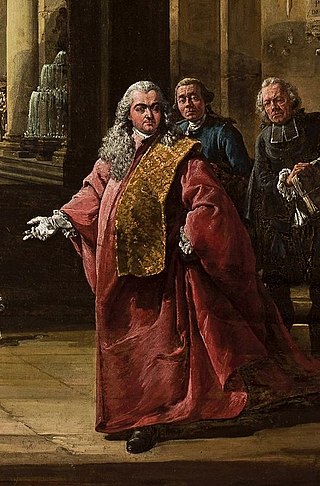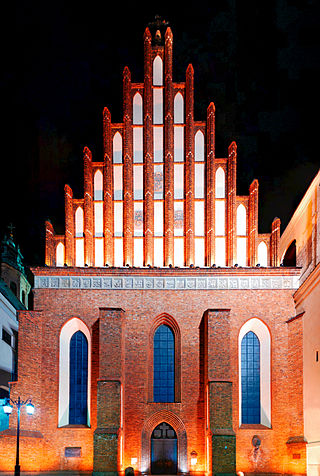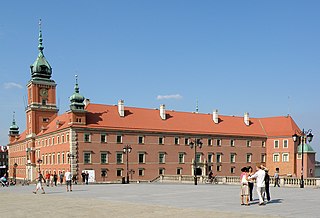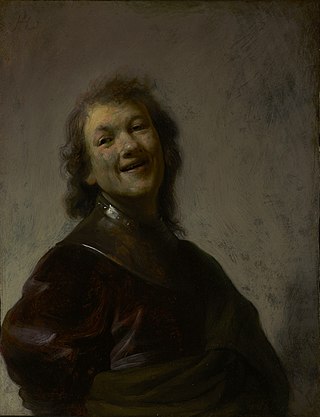
Bernardo Bellotto, was an Italian urban landscape painter or vedutista, and printmaker in etching famous for his vedute of European cities – Dresden, Vienna, Turin, and Warsaw. He was the student and nephew of the renowned Giovanni Antonio Canal, known as Canaletto, and sometimes used the latter's illustrious name, signing himself as Bernardo Canaletto. In Germany and Poland, Bellotto called himself by his uncle's name, Canaletto. This caused some confusion, however Bellotto’s work is more sombre in color than Canaletto's and his depiction of clouds and shadows brings him closer to Dutch painting.

The Royal Castle in Warsaw is a state museum and a national historical monument, which formerly served as the official royal residence of several Polish monarchs. The personal offices of the king and the administrative offices of the royal court were located in the Castle from the 16th century until the final partition of Poland in 1795. Situated in the Castle Square, at the entrance to the Old Town, the Royal Castle holds a significant collection of Polish and European art.

St John's Archcathedral is a Catholic church within the Old Town precinct in Warsaw, Poland. The Brick Gothic structure stands on Świętojańska Street, adjacent to the Jesuit Church. St John's is one of three major cathedrals in the city, but it is the only temple that also possesses the title of an archcathedral. It is the mother church of the Archdiocese of Warsaw and one of Poland's national pantheons. Along with the old city, the church has been listed by UNESCO as a World Heritage Site.

The Palais Lanckoroński was a palace in Vienna, Austria, located at Jacquingasse 16-18, in the Landstraße District. It was constructed in 1894-95 for Count Karol Lanckoroński and his family as a personal residence, and it housed the count's enormous art collection. The palace was built in a neo-baroque style by the theatre architects Ferdinand Fellner and Hermann Helmer. The building was three stories high, set back from the street, and protected by a wall with double gates. The entrance hall was wood panelled, two stories high, and decorated with portraits of the family. Other festive halls were decorated with frescoes and luxurious gobelin tapestries from the 17th century. Precious paintings, furniture and sculpture from different eras were arranged to form themed ensembles in the various rooms, with the rooms named to reflect the collection housed within. The palace was severely damaged in World War II, and was torn down in the 1960s.

Rembrandt Harmenszoon van Rijn, usually simply known as Rembrandt, was a Dutch Golden Age painter, printmaker, and draughtsman. He is generally considered one of the greatest visual artists in the history of Western art. It is estimated Rembrandt produced a total of about three hundred paintings, three hundred etchings, and two thousand drawings.

The Warsaw National Museum, also known as the National Museum in Warsaw, is a national museum in Warsaw, one of the largest museums in Poland and the largest in the capital. It comprises a rich collection of ancient art, counting about 11,000 pieces, an extensive gallery of Polish painting since the 16th century and a collection of foreign painting including some paintings from Adolf Hitler's private collection, ceded to the museum by the American authorities in post-war Germany. The museum is also home to numismatic collections, a gallery of applied arts and a department of oriental art, with the largest collection of Chinese art in Poland, comprising some 5,000 objects.

The Copper-Roof Palace is an 18th-century palace in Warsaw, Poland. It takes its name from the copper roof, a rarity in the first half of the 18th century. Since 1989 the palace has been a branch of the Royal Castle Museum.

Abraham Hendriksz van Beijeren or Abraham van Beyeren was a Dutch Baroque painter of still lifes. Little recognized in his day and initially active as a marine painter, he is now considered one of the most important painters of still lifes, and still lifes of fish and so-called 'pronkstillevens', i.e. sumptuous still lifes of luxurious objects.

The Palace on the Isle, also known as the Baths Palace, is a classicist palace in Warsaw's Royal Baths Park, the city's largest park, occupying over 76 hectares of the city center.
Events from the year 1641 in art.

The Royal Castle in Warsaw was a seat of the Sejm and Senate of the first Rzeczpospolita and also an official residence of the monarchs in Warsaw. It contained the offices of a number of political institutions, arranged around a central courtyard.

The Royal Library in Warsaw is a prominent building located adjacent to the Royal Castle in Warsaw, Poland. Constructed between 1779 and 1783, the library was designed by architects Dominik Merlini and Jan Chrystian Kamsetzer to house the royal book collection of King Stanisław August Poniatowski, the last sovereign King of Poland.

The Constitution of 3 May 1791 is an 1891 Romantic oil painting on canvas by the Polish artist Jan Matejko. It is a large piece, and one of Matejko's best known. It memorializes the Polish Constitution of 3 May 1791, a milestone in the history of the Polish–Lithuanian Commonwealth and a high point of the Polish Enlightenment.

Waleria Tarnowska was a Polish patron of the arts and painter in her own right, known for miniatures, numerous portraits, religious paintings and drawings.

The Scholar at the Lectern or The Father of the Jewish Bride is a 1641 oil on panel painting by the Dutch artist Rembrandt. With The Girl in a Picture Frame and Landscape with the Good Samaritan, it is one of only three Rembrandt paintings in Polish collections. It is currently located at the Royal Castle in Warsaw.
Dr. hab. Józef Grabski is a Polish born art historian, he is also a director of the Institute for Art Historical Research IRSA since its founding in 1979, also a publisher and editor-in-chief of Artibus et Historiae.
Franciszek Stanislaw Kostka Hutten-Czapski, Leliwa coat of arms - Count, Polish Senator, the last Governor of Chelmno, Member of the Bar Confederation. Knight of the Order of the White Eagle (Poland)(1762). An exhibition at the Royal Castle, Warsaw between November 9, 2005 and January 31, 2006, exhibited what was purported to be Franciszeks Order of the White Eagle, donated to the National Museum, Kraków by Emeryk Hutten-Czapski.

The Election of Stanisław August is a 1778 oil-on-canvas painting by Bernardo Bellotto, produced to the instructions of its subject Stanisław August Poniatowski and now hanging alongside twenty-two other paintings by the artist in the Senatorial Hall of the Royal Castle, Warsaw, also known as the Canaletto Hall. A first version produced in 1776 had not met with Stanisław August's approval and instead was given to Crown Marshal Franciszek Rzewuski; it is now in the National Museum, Poznań. Both works show the 1764 Polish–Lithuanian royal election, the last free royal election in the Polish–Lithuanian Commonwealth.

Rembrandt Laughing is a c. 1628 oil on copper painting by the Dutch painter Rembrandt van Rijn. It is an elaborate study of a laughing face, a tronie, and, since it represents the painter himself, one of over 40 self-portraits by Rembrandt, probably the earliest elaborate one. The painting, which was only recently discovered, is now in the J. Paul Getty Museum, California.

Krzysztof Józef Werner (1718–1778) was a Polish-Swiss painter. Who Worked On miniature portraits. He was employed first by King Augustus III.


















